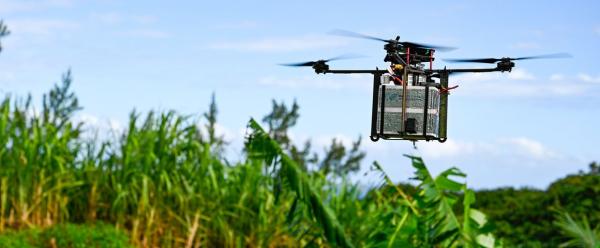Results & impact 10 October 2025
- Home
- Press area
- Press releases
- Contaminants organic waste
Contaminants: blind spots in organic waste recycling

Processing green waste in La Réunion © J. Vayssières, CIRAD
Turning organic waste derived from urban, agricultural and agro-industrial processes into agricultural resources is an interesting idea from a sustainable development and circular economy perspective, “provided we remember that waste may contain potentially toxic substances”, as one of the authors of the study published in May points out.
These substances are “contaminants”, in other words elements introduced into the natural environment by human activities. “Such contaminants are referred to as pollutants when they degrade the functioning of this natural environment, for example due to their toxicity”, explains Emmanuel Doelsch, a researcher at CIRAD and co-author of the study.
Three types of contaminants present in organic waste
Trace elements (metals and metalloids), sometimes incorrectly referred to as “heavy metals”, are the most studied contaminants. These elements include copper and zinc, which although essential to life, become toxic above a certain concentration.
Organic contaminants include a very wide range of substances, such as pesticides, industrial substances (dioxins, PCBs, PAHs, etc.), pharmaceuticals and personal care products.
Finally, pathogens include viruses and other parasites present in organic waste. Among their impacts, the authors highlight the presence of antibiotic-resistant bacteria due to the antibiotics found in organic waste. According to the study, between 30 and 90% of the antibiotics used in livestock production are subsequently found in manure.
Cocktail effects, organic contaminants and pathogens: blind spots of assessments
Faced with the presence of these contaminants, the decision to implement agricultural recycling depends on an assessment of the potential risks and benefits. To this end, scientists, decision-makers and farmers use two methods to assess environmental and health risks: life cycle analysis and risk analysis. However, both methods have a number of shortcomings.
According to the study, organic contaminants and pathogens are very rarely included in these assessments. Trace elements are covered, but some of their specificities are overlooked, such as their chemical form. “Some types of organic waste undergo a transformation, for example during composting”, explains Emmanuel Doelsch. “The metals present change form during this stage, which may impact their behaviour in the environment and their toxicity”.
The other blind spot that concerns scientists is the cocktail effect. “Current methodologies assess the toxicity of trace elements taken individually”, says Angel Avadí, a researcher at CIRAD and co-author of the study. “They do not take account of the effects of mixtures. However, some metals are harmless in isolation, but become toxic in the presence of other contaminants, or vice versa”.
Closing the gap between local knowledge and global assessment methods
At the local level, the impacts of recycling organic waste can be analysed through dedicated experimental sites. CIRAD is working, for example, on long-term field experiments (sometimes more than 15 years) in Réunion as well as in partnership with national organisations in tropical countries, such as Senegal.
The very detailed knowledge produced is not always appropriate for larger scale assessments or different climate contexts, as noted by Angel Avadí. “To have an impact in decision-making, assessment methods need to be able to give an overall picture. This implies simplifying and aggregating a large amount of data”.
According to the authors, “it is all a matter of selecting the parameters to be prioritised in these assessments”. They thus advocate making changes to the parameters, for example, by including certain cocktail effects.
As underlined by Emmanuel Doelsch and Angel Avadí, “agricultural recycling of organic waste is a good option, but we need to be keep in mind the different risks, which means we need to be capable of measuring them”.
Reference
Angel Avadí, Pierre Benoit, Matthieu N. Bravin, Benoit Cournoyer, Frédéric Feder, Wessam Galia, Patricia Garnier, Claire-Sophie Haudin, Samuel Legros, Laure Mamy, Sylvie Nazaret, Dominique Patureau, Valérie Pot, Laure Vieublé Gonod, Tom Wassenaar, and Emmanuel Doelsch. 2022. Trace contaminants in the environmental assessment of organic waste recycling in agriculture: Gaps between methods and knowledge. Advances in Agronomy Volume 174, 2022, Pages 53-188



























